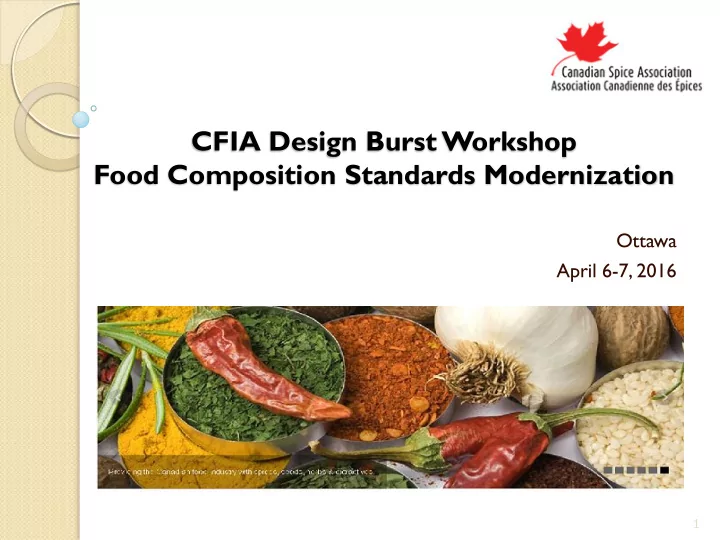

CFIA Design Burst Workshop Food Composition Standards Modernization Ottawa April 6-7, 2016 1
Food Composition Standards - Background • Workshop using Design Thinking as an approach to modernizing the Food Standards. • Industry participants – Retail, Poultry, Meat, Bakers, Fruit and Vegetable, Spice, Flavours, Dairy, Beer, Beverage, Vintners, Spirits. Government – CFIA, HC, Agriculture Canada, General Standards Board, Innovation Science & Economic Development, Public Health. • What are Food Compositional Standards? • Introduced in 1800s to address issues of adulteration. • Ingredients and processes identify a particular food, what a food shall or may contain (composition, strength, potency, purity, quality), nutritional quality and food safety (microbiological, chemical or physical).
Food Composition Standards – Why Modernize? Why modernize Food Compositional Standards? ◦ Changing needs of consumers & industry. ◦ CFIA & HC transformation and modernization agenda. ◦ Consolidation of standards into the new Safe Food for Canadians Regulations. ◦ New regulatory tools eg. Incorporation by Reference. What are the issues with Food Compositional Standards? ◦ 500+ federal standards ◦ Inconsistencies in and/or duplication of standards (FDR vs. CAPA/FIR/MIR/other regulations) ◦ Standards do not reflect marketplace realities, innovation and technological advances, trade barriers, un-level playing field for Canadian manufacturers. ◦ Categories identifying issues: Processed Fruits & vegetables, alcohol, dairy, spices, flavours, grain & bakery, fats and oils, meat.
Food Composition Standards – Why Modernize? When are compositional standards required? What values do standards provide? What is the job of a food standard? What foods need a standard? What tools are available other than Incorporation by Reference? How are standards done in different jurisdictions?
Food Composition Standards – International Framework Canada - 500+ food standards in 27 categories (Divisions) within the FDR and proposed SFCR. USA – 338 standards in 23+ categories within the CFR. Australia/New Zealand - 36 standards in 10 categories with FSANZ. ◦ Revamp Dec 2000 (prior 250+ standards in NZ). ◦ Food Standards Code: Chapter 1- General Food Standards, Chapter 2- Food Product Standards, Chapter 3 - Food Safety Standards, Chapter 4 - Primary Products Standards. Chapters 1,3,4 – General provisions. Codex (International) – 212 standards in 12 categories.
Design Thinking Day 1: Value and Role of Standards: Jobs to be done – for Who (specific role or person), a standard does What (does something that starts with a verb), so that Why (the benefit). Day 2: Simplify the standards system, what are the alternatives and how might we get there? ◦ SCAMPER (cards) – Substitute, Combine, Adapt, Magnify/Modify, Put to other use, Eliminate, Reverse/reorder. ◦ “Currents” template – Contributing currents (what pushes us forward), Opposing currents (what holds us back), Diverting currents (what distracts), Reinforcing currents (root causes). Incorporation by Reference, Quantitative ingredient declaration, Industry codes of practice (voluntary approach eg. National Dairy code), Grouping related products into one standard, Generic standards (general, food safety, primary products).
Division 7 CFIA will not support complete repeal of the spice standards. Adulteration is the concern if standards are eliminated, a standard must remain in regulation to protect consumers. Think about which ones are needed and what we need them to do…remove only the unnecessary complexity. Link to the botanical source. ◦ B.07.001 . [S] Allspice or Pimento, whole or ground, shall be the dried, full but unripe whole berries of Pimenta dioica (L) Merr. ◦ Include a reference that no portion is removed, eg. FDA - Aromatic vegetable substances, in the whole, broken, or ground form, whose significant function in food is seasoning rather than nutrition. They are true to name and from them no portion of any volatile oil or other flavoring principle has been removed. ◦ Consider a “Naming the Spice” standard to cover new spices. Eg. B.07.XXX [S] Spices shall be obtained entirely from the botanical source after which they are named and from them no portion of any volatile oil or other flavoring principle has been removed. Revise and re-submit.
Recommend
More recommend